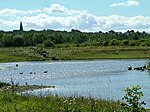Houghton-le-Spring

Houghton-le-Spring ( HOH-tən-lee-SPRING) is a town in the City of Sunderland, Tyne and Wear, North East England which has its recorded origins in Norman times. Historically in County Durham, it is now administered as part of the Tyne and Wear county. It is situated almost equidistant between the cathedral city of Durham 7 miles (11 kilometres) southwest and Sunderland about 7 mi (11 km) northeast. The town of Seaham and the North Sea lie about 5 mi (8 km) directly east. The villages and towns of Newbottle, Fencehouses and Hetton-le-Hole lie nearby. It has a population of 36,746.Other villages within the Houghton-le-Spring postal district include: Philadelphia, Penshaw, Shiney Row, Chilton Moor and Woodstone Village.
Excerpt from the Wikipedia article Houghton-le-Spring (License: CC BY-SA 3.0, Authors, Images).Houghton-le-Spring
A690, Sunderland Houghtonside
Geographical coordinates (GPS) Address Nearby Places Show on map
Geographical coordinates (GPS)
| Latitude | Longitude |
|---|---|
| N 54.841 ° | E -1.468 ° |
Address
A690
DH4 4DH Sunderland, Houghtonside
England, United Kingdom
Open on Google Maps





